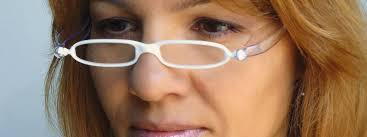The science behind reading glasses
Reading glasses work by using convex lenses to correct the refractive error that causes difficulty in seeing close-up objects. This is due to the shape of the eye, which causes light to focus unevenly on the retina, leading to blurred vision. Here is the science behind how reading glasses work
Refractive Error - Refractive error occurs when the shape of the eye causes light to focus unevenly on the retina. This can be caused by a variety of factors, including age, genetics, and environmental factors such as exposure to UV rays or blue light.
Convex Lenses - Reading glasses use convex lenses to correct refractive error. Convex lenses are thicker in the center than at the edges, which causes light to bend as it passes through the lens. This helps to focus the light directly onto the retina, improving clarity and reducing eye strain.
Diopters - The strength of the
magnification in reading glasses is measured in diopters, which is the unit of
measurement for the power of the lens. The higher the number of diopters, the
stronger the magnification of the lens. The strength of the glasses is
determined by the individual's specific vision needs and can be prescribed by
an eye doctor.
Accommodation - Accommodation is the ability of the eye to change focus from distant to near objects. As we age, the lens of the eye becomes less flexible, making it more difficult to accommodate. This can lead to presbyopia, a condition in which the eye's ability to focus on near objects diminishes. Reading glasses can provide magnification for close-up tasks, making it easier for individuals with presbyopia to read and perform other close-up work.
Magnification - Magnification is the process of making an object appear larger than its actual size. Reading glasses magnify the text or object being viewed, making it easier to see and read. The strength of the magnification is determined by the strength of the lens, which is measured in diopters.
Lens Materials - Reading glasses can be made from a variety of lens materials, including glass, plastic, and polycarbonate. Each material has its own advantages and disadvantages, such as durability, weight, and scratch resistance.
Prescription - While reading glasses can be purchased over-the-counter, prescription glasses are customized to the individual's specific vision needs. Prescription glasses can correct refractive errors such as nearsightedness, farsightedness, and astigmatism, as well as provide magnification for close-up tasks.
Reading glasses work by correcting refractive error using convex lenses that bend light and focus it directly onto the retina. The strength of the magnification is measured in diopters and is determined by the individual's specific vision needs. Accommodation, the ability of the eye to change focus, can be improved with reading glasses, which can provide magnification for close-up tasks. Lens materials and prescription needs can vary depending on the individual's preferences and vision needs. By understanding the science behind reading glasses, individuals can make informed choices about their eyewear and enjoy clear and comfortable vision for reading and other close-up tasks.
The disadvantages of wearing reading
glasses
While reading glasses can provide many benefits for individuals with near vision problems, there are also some disadvantages to wearing them. Here are some of the disadvantages of wearing reading glasses
Dependency - Wearing reading glasses can create a dependency on them, as the eyes may become accustomed to the magnification provided by the glasses. This can make it difficult to read or perform close-up work without the glasses, leading to discomfort or decreased productivity.
Adjusting to the Glasses - It may take some
time for the eyes to adjust to wearing reading glasses, especially for
individuals who have not worn glasses before. Some people may experience
headaches, dizziness, or eye strain during the adjustment period, which can be
uncomfortable.
Cost - Depending on the prescription and materials used, reading glasses can be expensive. This can be a disadvantage for individuals who need multiple pairs of glasses or who have limited financial resources.
Inconvenience - Wearing reading glasses can be inconvenient at times, as they need to be carried and put on and taken off as needed. This can be especially inconvenient for individuals who need to switch between reading and distance vision frequently.
Social Stigma - Some individuals may feel self-conscious or embarrassed about wearing reading glasses, which can lead to social stigma or anxiety. This can be a disadvantage for individuals who have concerns about their appearance or who feel uncomfortable wearing glasses in public.
In conclusion, while reading glasses can
provide many benefits for individuals with near vision problems, there are also
some disadvantages to wearing them, including dependency, adjustment period,
cost, inconvenience, and social stigma. It is important to weigh the pros and
cons of wearing reading glasses and work with a healthcare provider to
determine the best course of action for achieving clear and comfortable vision.





评论
发表评论